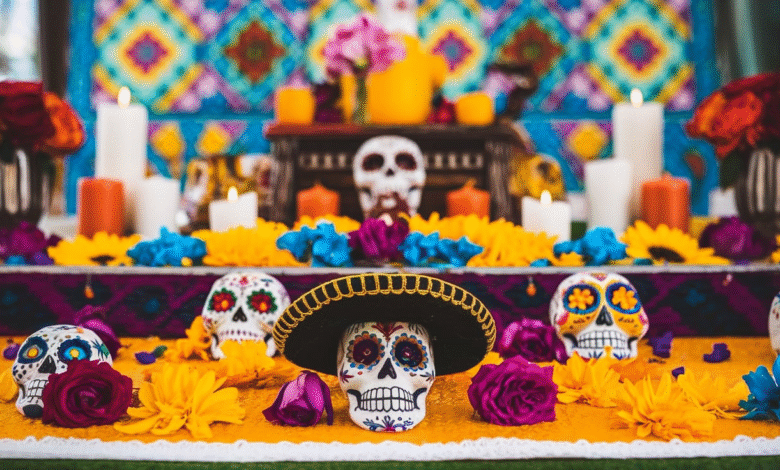Day of the Dead Art: Colors, Symbols, and Meaning Behind the Tradition

Day of the Dead art is full of life, color, and stories. This art is not about sadness, but about remembering people we love who have passed away. When you see day of the dead art, you will notice bright flowers, sugar skulls, and skeletons dressed in fun clothes. Each picture and design tells a story about family, love, and respect. Many artists use strong colors like pink, yellow, and blue to show joy and celebration. The art is not scary—it is happy and lively. It shows that death is not an end but a way to keep memories alive. Families in Mexico and other places use art to decorate altars and graves to welcome back the spirits. This tradition is very old, and the art keeps it alive for new generations.
Day of the Dead art has many styles. Some are traditional, made by hand with wood, clay, or paper. Others are modern, painted with brushes or created digitally. Both kinds are important because they tell the same story in different ways. Traditional art is often made by families who have passed down their craft for many years. You can find papel picado (cut paper banners), colorful masks, and handmade skeleton figures. Modern artists bring their own twist, painting skeletons driving cars, playing guitars, or dancing. Some people buy prints and posters to hang in their homes, while others love to collect handmade pieces from local markets. The art connects past and present, reminding us that love does not end, even when someone is gone.
What Is Day of the Dead Art and Why It Matters
Day of the Dead art is more than just pretty pictures; it is a way to honor family and friends who have passed away. This kind of art is used during Día de los Muertos, a Mexican holiday that celebrates life and death together. Artists use bright colors, smiling skeletons, and detailed designs to show joy instead of fear. The art helps families remember good times with their loved ones. It is not meant to be scary, but happy and full of meaning. You will often see it on altars, in cemeteries, and even in homes. Each piece tells a story of love and memory. People use papel picado, sugar skulls, and painted faces to welcome spirits back for a short visit. This art matters because it keeps tradition alive while also sharing happiness with new generations everywhere.
Symbols You See in Day of the Dead Art
Symbols in day of the dead art are very special, and each one has meaning. Skulls, also called calaveras, are one of the most common symbols. They can be made of sugar, clay, or even painted on faces, showing that death can be sweet and playful. Flowers, especially marigolds, are used to guide spirits with their bright colors and strong scent. Candles are another symbol that light the way home for loved ones. Skeletons, or calacas, are often shown dancing, laughing, or playing music, reminding everyone that life and death are part of one circle. Papel picado, the colorful cut-paper banners, stand for the fragile nature of life. All these symbols together create a happy picture instead of a sad one. They tell us that memories of family and friends will never fade away.
Traditional Day of the Dead Art from Mexico
Traditional day of the dead art is handmade and passed down through families for many years. Artists use clay, wood, and paper to make items that show respect and joy. In towns across Mexico, you will find sugar skulls decorated with colorful icing, papel picado banners cut into shapes, and wooden skeleton figures called calacas. Masks and small shadow boxes, called nichos, are also very popular. Many of these crafts are made by local artisans who learned the skills from parents and grandparents. Each item has bright colors and simple details that make it special. These traditional works are not just decorations; they are pieces of culture. Families place them on altars or carry them to cemeteries during Día de los Muertos. This art keeps history alive while letting families celebrate together.
Modern Styles of Day of the Dead Art
Modern day of the dead art brings a fresh look to an old tradition. Today, many artists paint skeletons in fun and creative ways, like playing guitar, riding motorcycles, or dancing at parties. Some even use digital tools to design colorful posters or prints that can be shared online. This shows how the holiday grows with time while still keeping its meaning. Unlike traditional crafts made from clay or paper, modern works often use canvas, metal, or even computer graphics. Artists mix old symbols, like skulls and marigolds, with new ideas to connect with young people. This style helps share the beauty of the holiday all around the world. People can now buy prints, t-shirts, or murals that celebrate Día de los Muertos in unique and personal ways.
Colors and Meanings in Day of the Dead Art
Colors are a big part of day of the dead art, and each one has a special meaning. Orange and yellow come from marigold flowers, which are called “flowers of the dead.” These colors guide spirits with light and warmth. Purple is used to show respect and honor for loved ones. Red often stands for the blood of life, while white means purity and hope. Blue can be used for water, which is offered on altars to refresh the spirits after their long journey. Together, these colors make the art bright, happy, and full of energy. Artists use them in sugar skulls, papel picado, face paint, and many other designs. The use of color shows that this holiday is not dark or scary but instead full of light and love that keeps memories alive.
Famous Artists Who Shaped Day of the Dead Art
Some artists have made day of the dead art known all around the world. One of the most famous is José Guadalupe Posada, who created the image of La Catrina, a fancy lady skeleton that has become a symbol of the holiday. His work showed that death comes for everyone, rich or poor, but in a way that was playful and smart. Other modern artists have followed his steps by making skeletons in creative and funny scenes. They keep the tradition alive while also adding new ideas. Many painters, carvers, and digital designers bring their own voices to the art, making it grow over time. These artists help spread Mexican culture across the globe. Their work shows that the holiday is not only about loss but also about celebration, humor, and family memory.
How Families Use Day of the Dead Art in Celebrations
Families use day of the dead art to make their celebrations full of color and meaning. During the holiday, they set up altars called ofrendas, decorated with photos, candles, marigolds, and handmade crafts. Papel picado banners hang above the altars, while sugar skulls and skeleton figures sit around food offerings. Many families also paint their faces like skulls, turning art into part of the celebration itself. In cemeteries, graves are decorated with flowers, candles, and small pieces of art to welcome loved ones back for the night. Some families buy modern art like posters or prints, while others make their own crafts at home. This use of art makes the holiday both personal and cultural. It gives people a way to remember, honor, and celebrate life together with joy instead of sadness.
Where to Find Day of the Dead Art Today
Day of the dead art can be found in many places today, from small village markets in Mexico to art galleries in big cities. Local artisans sell handmade crafts like masks, papel picado, and sugar skulls during the season. Street markets are filled with bright and unique items, each one made with love and care. For people living outside Mexico, many online shops now offer prints, posters, and decorations that capture the spirit of the holiday. Art fairs, museums, and cultural festivals also display works that celebrate this tradition. Whether traditional or modern, these pieces allow everyone to take part in Día de los Muertos, no matter where they live. Finding and sharing this art helps keep the culture alive and lets more people understand its meaning.
Conclusion
Day of the dead art is more than just decoration. It is a way to connect families, share memories, and celebrate life. From sugar skulls to colorful papel picado, every piece has meaning. This art helps people honor loved ones with joy instead of sadness, making the holiday very special. It shows us that even when someone is gone, their spirit can still feel close.
This tradition keeps growing because artists mix old styles with new ideas. Traditional crafts, modern paintings, and even digital art all share the same message: love never ends. Day of the dead art keeps history alive and lets new generations celebrate with pride. It teaches that remembering loved ones can be beautiful and happy, no matter how much time has passed.
FAQs
Q: What is day of the dead art?
A: It is colorful art used during Día de los Muertos to honor and remember loved ones who passed away.
Q: Why are skeletons used in day of the dead art?
A: Skeletons show that death is part of life, and they are often drawn happy to celebrate memory, not fear.
Q: What materials are used in traditional day of the dead art?
A: Artists use clay, wood, paper, sugar, and flowers to make traditional items like skulls and papel picado.
Q: Who created the famous La Catrina image?
A: The artist José Guadalupe Posada created La Catrina, a well-known skeleton lady in Mexican culture.
Q: Can I find day of the dead art outside Mexico?
A: Yes, many online shops, galleries, and festivals around the world now share this unique and colorful art.




